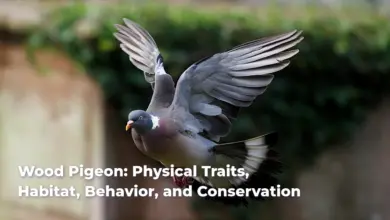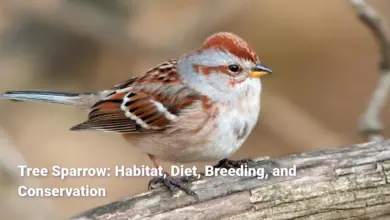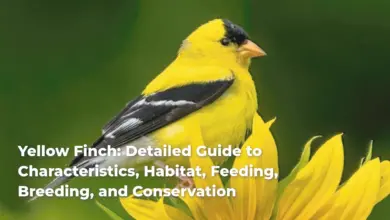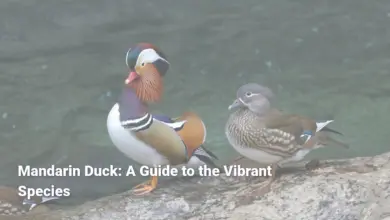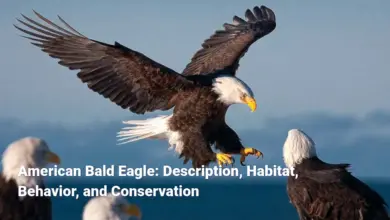Cooper’s Hawk Bird: A Comprehensive Guide
A Deep Dive into the Life and Ecology of the Cooper's Hawk Bird
Cooper’s Hawk: A Comprehensive Guide
The Cooper’s Hawk (Accipiter cooperii), a striking bird of prey, commands attention with its impressive agility and keen predatory skills. This medium-sized raptor boasts a captivating presence that enchants birdwatchers and captures the imagination of wildlife enthusiasts. Found predominantly across North America, from the southern reaches of Canada to Mexico, the Cooper’s Hawk exhibits a remarkable adaptability, thriving in varied habitats, including forests, urban settings, and even rural farmlands. Its sharp eyesight, rapid flight, and sociable nature contribute to its success as an efficient hunter, primarily preying on smaller birds and some mammals.
Cooper’s Hawks are more than just skilled hunters; they engage in complex social behaviors and exhibit fascinating nesting habits that showcase their adaptability and resourcefulness. This guide aims to delve into the various dimensions of the Cooper’s Hawk, exploring its habitat, hunting techniques, diet, conservation status, and unique adaptations. By understanding this magnificent raptor’s role in the ecosystem and its interplay with human-altered landscapes, we can appreciate the ongoing story of the Cooper’s Hawk a tale of resilience, survival, and a lifelong quest for sustenance.
Habitat and Distribution of Cooper’s Hawk
Cooper’s Hawks are known for their diverse habitat preferences, which range across various regions of North America. Picture a versatile artist, adept at painting its existence across an expansive canvas of environments forests adorned with towering trees, bustling urban areas, and tranquil suburban spaces. The Cooper’s Hawk thrives particularly well in mixed coniferous and deciduous forests, where it can find abundant prey while remaining concealed amidst the leaves and branches.
Summary of Habitat and Distribution
- Common Habitats: Cooper’s Hawks inhabit mature forests, shrubby areas, riparian zones, and urban environments. They favor locations with ample cover for hunting.
- Geographic Range: Their distribution extends throughout the continental United States, including parts of southern Canada and as far south as Mexico.
- Migration Behavior: While some birds migrate south for the winter, others stay within their breeding territories in the southern regions, demonstrating an adaptability that allows them to exploit varying food sources and habitat types.
- Urban Integration: Notably, the Cooper’s Hawk has increasingly adapted to urban settings, nesting within residential neighborhoods and thriving in areas modified by human activities.
In essence, the Cooper’s Hawk’s ability to traverse and thrive in such widely varied habitats speaks volumes about its ecological flexibility. It serves as a poignant reminder of the delicate balance that exists between wildlife and human influence, emphasizing the need for conservation efforts to ensure the ongoing survival of species that have adapted to coexist with urban environments.
Regional Habitats of Cooper’s Hawk
The Cooper’s Hawk enjoys an expansive array of habitats that encompass different geographical regions. Each area it inhabits serves as a unique stage where this raptor demonstrates its remarkable adaptability and predation skills.
- Northern Forests: In states like Minnesota and Wisconsin, Cooper’s Hawks are typically found in coniferous and mixed forests. These environments are rich in birds, allowing the hawks to leverage their hunting prowess amidst thick foliage. The dense cover serves as both a hunting ground and a nesting area, providing protection from harsh winter weather.
- Suburban Landscapes: The adaptability of Cooper’s Hawks shines in suburban settings. Here, they often nest in tall trees found in parks and residential backyards. This urban integration exemplifies how the hawks have capitalized on additional food sources, such as backyard bird feeders, increasing their foraging success.
- Riparian Zones: In regions with abundant waterways, Cooper’s Hawks flourish near rivers and streams. This habitat not only supplies a diverse range of prey, including small mammals and birds, but also offers opportunities for hunting techniques advantageous in both aerial and ground pursuits.
- Agricultural Areas: In some regions, Cooper’s Hawks can be seen in agricultural fields where they hunt for small rodents and birds attracted to crops. These areas, though altered by human activity, still provide essential resources, adding another layer to the hawk’s varied habitat scope.
Ultimately, the regional habitats of the Cooper’s Hawk emphasize its ecological agile nature. Whether in dense forests or human-modified outskirts, these birds remind us of nature’s resilience and adaptability. They carve out niches in varied landscapes, highlighting the intricate relationships that exist between wildlife and their environments.
Seasonal Migration Patterns
The seasonal migration patterns of Cooper’s Hawks reveal an extraordinary aspect of their behavior, showcasing their adaptive responses to fluctuations in temperature and food availability. During the late summer months, adult Cooper’s Hawks typically begin to migrate south, marking the start of a journey that will take them across the United States and into Mexico. This migration serves as a survival strategy that enables them to escape frigid climates and seek out warmer, more abundant environments during winter.
Migration Overview
- Timing: Migration generally occurs from late August to early November, when temperatures begin to drop and daylight hours shorten.
- Breeding versus Resident Populations: Individual hawks in southern regions of the U.S., particularly in states like Florida and Texas, are more likely to remain year-round residents due to milder climates and continued prey availability.
- Return Patterns: By mid-spring, Cooper’s Hawks return to their breeding territories, a movement usually complete by late April or May. Notably, they often return to the same nesting sites year after year.
- Flyways and Behavior: Cooper’s Hawks often utilize specific migration routes and flyways, flying solo or in small groups of breeding pairs. This wandering behavior contrasts with some species that gather in larger flocks.
During migration, these hawks face numerous challenges, including extreme weather, lack of food, and potential encounters with predators. However, their keen sense of direction and remarkable instincts enable them to navigate these obstacles effectively. The migratory patterns of Cooper’s Hawks illuminate their resilience and adaptability, showcasing how they have thrived despite changing environmental conditions while encouraging wildlife enthusiasts to monitor and protect their migratory routes.
Behavior and Characteristics of Cooper’s Hawk
The behavior and characteristics of the Cooper’s Hawk underscore its prowess as a skilled predator while also revealing a complex social structure that enhances its survival. Typically recognized for their unique predatory techniques, these hawks exhibit behaviors that reflect their adaptability to a range of habitats and challenges.
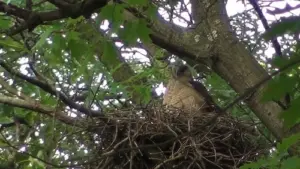
Summary of Key Behaviors
- Agility and Stealth: Cooper’s Hawks are agile fliers, capable of rapid maneuvers and impressive aerial speeds. Their hunting techniques involve stealth, often ambushing prey from perches or stalking quietly through dense foliage.
- Social Interactions: Generally monogamous during the breeding season, pairs of Cooper’s Hawks often return to the same nesting territory each year, fostering strong connections. Their social behaviors extend beyond just pairing; they communicate through vocalizations and displays to defend their territory against rival hawks.
- Nesting and Brood Care: The nesting period begins in late winter or early spring, with females laying clutches of 2 to 6 eggs. Both parents participate in incubating the eggs and nurturing the young, showcasing their collaborative parenting style.
- Adaptability: Cooper’s Hawks thrive in both natural forested environments and urban settings, illustrating their remarkable ability to adjust to human-influenced landscapes. This adaptability is crucial for their survival in changing ecosystems.
In summary, the behaviors and characteristics of Cooper’s Hawks highlight their formidable hunting skills and social structures, providing a glimpse into their complex lives. These traits not only define their role as effective predators but also showcase their ability to thrive in diverse environments, making them an essential component of their ecosystems.
Hunting Techniques of Cooper’s Hawk
Hunting is an art for the Cooper’s Hawk, filled with techniques as nuanced and strategic as a well-rehearsed dance. Adapted to a life of stealth and speed, this raptor employs several key hunting methods that reflect its capabilities and make it an effective predator.
- Ambush Hunting: Cooper’s Hawks utilize their exceptional camouflage to blend into their surroundings, often perching silently within dense foliage. This stealth mode allows them to remain undetected as they wait for unsuspecting prey to wander into striking distance. When the moment is right, they explode from their concealed location with astonishing speed and precision, resembling a flash of lightning in the underbrush.
- Aerial Maneuverability: Known for their speed and agility, Cooper’s Hawks possess specialized wings that facilitate rapid acceleration. They are adept at navigating through dense trees while pursuing smaller birds in flight. Their unparalleled aerial skills resemble that of a fighter jet weaving through complex terrain, allowing them to hunt efficiently in densely wooded areas.
- Adaptability in Hunting: Cooper’s Hawks demonstrate versatility in their hunting techniques, adapting their approach based on the type of prey available. In urban and suburban environments, they may target backyard feeders frequented by small birds, while in open fields, they may hunt small mammals. This dietary flexibility ensures their continuous success as predators.
- Ground Pursuit: While often thought of as aerial hunters, Cooper’s Hawks are also known to pursue prey on the ground. Their agility allows them to chase down roosting or foraging birds that may have moved into open spaces where they can be easily captured.
These carefully crafted hunting techniques underscore the Cooper’s Hawk’s adeptness and survival skills, making it a striking player in the intricate web of avian predators. Their hunting style not only reveals their impressive physical attributes but also highlights the delicate balance of nature, emphasizing the importance of preserving their habitats for future generations to experience.
Social Behavior and Nesting Habits
Social behavior and nesting habits constitute an integral part of the ecology of Cooper’s Hawks. Throughout their lifespan, these raptors exhibit fascinating social interactions and cooperative parenting strategies that contribute to their success as a species.
- Nesting Dynamics: Cooper’s Hawks typically select mature trees with dense foliage for nesting. They construct large nests made of sticks, often returning to the same site year after year, contributing to the continued success of their breeding efforts. The nests serve as a secure haven for their young during the critical early phases of development.
- Monogamous Pairing: These birds generally form monogamous pairs for the duration of the breeding season. The male takes an active role in both nest building and parental duties, providing food for the female as she incubates the eggs. This collaborative approach nurtures strong social bonds and increases the likelihood of feeding their chicks successfully.
- Parental Care: After the eggs hatch, both parents play a role in feeding the chicks. The male primarily hunts for food while the female remains with the young, ensuring their safety. This division of labor reflects their commitment to the survival of their offspring, emphasizing the importance of teamwork in parenting.
- Territorial Behavior: During the breeding season, Cooper’s Hawks establish and defend their territories from intruders. To assert dominance, they engage in aerial displays and vocalizations, communicating their presence and intent to protect their nesting site.
These behavioral aspects not only highlight the impressive capabilities of Cooper’s Hawks as solitary hunters but also paint a picture of their intricate social network. Through their nesting habits and social interactions, these hawks embody a balance of independence and cooperation, showcasing the beauty and complexity of avian life.
Diet of Cooper’s Hawk
The diet of the Cooper’s Hawk (Accipiter cooperii) reflects its role as a crucial predator in the ecosystem, primarily consisting of various small to medium-sized animals that change based on environmental availability. This raptor’s dietary preferences provide insight into its habitat utilization and hunting strategies.
Summary of Diet
- Key Prey: Cooper’s Hawks primarily hunt small to medium-sized birds, such as robins, sparrows, and doves, along with small mammals and occasionally reptiles or insects.
- Hunting Locations: They adapt their hunting methods based on location, targeting birds at feeders in urban settings or stalking rodents in agricultural areas.
- Diet Flexibility: Their ability to exploit various food sources underscores their resilience and adaptability, allowing them to thrive in diverse habitats.
The dietary composition of the Cooper’s Hawk influences not just its foraging behavior, but also plays a role in maintaining the balance of bird populations within its territory, reinforcing its significance in the food chain.
Primary Food Sources of Cooper’s Hawk
The primary food sources of Cooper’s Hawks reflect their adaptability as predators, showcasing a diverse palate that allows them to thrive in various environments.
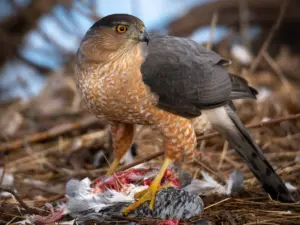
- Small Birds: Cooper’s Hawks predominantly prey on small to medium-sized birds, which make up the bulk of their diet. During spring and summer, they often target songbirds like sparrows, jays, and robins, using their stealth and rapid agility to capture them while they forage.
- Small Mammals: While avian prey dominates their diet, Cooper’s Hawks will also hunt small mammals such as mice, rats, voles, and squirrels when birds are scarce. Their hunting techniques allow for surprising efficiency in capturing these ground-dwelling creatures, particularly in agricultural settings.
- Reptiles and Amphibians: Although less common, Cooper’s Hawks may also consume smaller reptiles, such as lizards and occasionally amphibians like frogs. Their opportunistic nature ensures they take advantage of varied prey sources, especially in areas where small mammals or birds may not be abundant.
- Insects: During specific seasons or in particular habitats, Cooper’s Hawks include insects in their diet, particularly when feeding fledglings. They may hunt down grasshoppers, beetles, or other small invertebrates to supplement nutrition for their young.
- Fish: In riparian habitats or near wetlands, fish can occasionally become part of their diet, particularly when hunting opportunities align with vulnerable species. This flexibility showcases their adaptability and resourcefulness in seeking sustenance.
Overall, the dietary habits of Cooper’s Hawks highlight their versatility as hunters. By targetting small birds, mammals, and other prey, they maintain a critical role in controlling animal populations, contributing to the balance within their respective ecosystems. Understanding these dietary traits sheds light on their ecological significance and places emphasis on the importance of conserving habitats that support their prey species.
Impact of Diet on Cooper’s Hawk Behavior
The diet of the Cooper’s Hawk significantly influences its behavior, demonstrating a direct correlation between dietary habits, hunting strategies, and adaptation to changing environments.
- Hunting Techniques: The composition of their diet dictates the hunting techniques employed by Cooper’s Hawks. As primarily avian predators, they often utilize ambush tactics from perches or stealthy sprints through low vegetation, adapting their behavior based on prey availability. When hunting in urban environments, they may shift their focus to birds near feeders, altering their hunting styles.
- Foraging Behavior: The availability of specific food sources influences foraging behaviors and territory selection. For example, in suburban areas with abundant feeders, Cooper’s Hawks may establish nesting territories closer to human activity. Meanwhile, in more rural or wild environments, they are likely to require diverse habitats that can sustain a broader range of prey species.
- Reproductive Success: Access to quality food directly impacts the reproductive success of Cooper’s Hawks. When prey populations are rich, it promotes healthier breeding outcomes, with ample food leading to larger and more vigorous broods. Conversely, in areas where prey is scarce, reproductive output may drop.
- Adapting to Urban Landscapes: Cooper’s Hawks exhibit remarkable adaptability in urbanized areas, highlighting a shift in behavior dictated by diet. They have learned to exploit the unique advantages offered by human development, and individuals that can successfully hunt in these environments have shown increased reproductive success, contributing to stable populations.
The profound impact of diet on the behavior of Cooper’s Hawks illustrates the intricate relationship between predation, adaptation, and environmental conditions. It further underscores their role as ecological players, adapting to varying landscapes while ensuring their survival through effective hunting and range expansion.
Conservation Status of Cooper’s Hawk
The Cooper’s Hawk faces various challenges and opportunities in the realm of conservation, showcasing both resilience and vulnerability. Once threatened by habitat loss and pesticide use, this raptor has undergone significant recovery in recent decades.
Summary of Conservation Status
- Population Trends: Cooper’s Hawk populations have rebounded successfully since the decline caused by DDT, and they are currently classified as “Least Concern” in the IUCN Red List. The recovery of their populations reflects the general resilience of this species.
- Geographic Variability: While the overall population is stable, localized or regional threats can impact specific populations, particularly in eastern U.S. states where they have been designated as endangered or threatened.
- Conservation Efforts: Ongoing research, habitat protection, and public awareness initiatives continue to steer conservation strategies, focusing on habitat cohesiveness and minimizing threats through community engagement.
The conservation status of Cooper’s Hawks serves as a testament to the efficacy of conservation endeavors, highlighting both the success of recovery efforts and the ongoing need to monitor their populations actively.
Threats to Cooper’s Hawk Population
Despite the overall rebound, the Cooper’s Hawk population faces several ongoing threats, presenting challenges for conservationists dedicated to ensuring its survival.
- Habitat Loss: One of the primary threats to Cooper’s Hawks is habitat loss due to urban development, deforestation, and agricultural expansion. While they thrive in urbanized settings, the loss of suitable nesting and foraging habitats can adversely affect their populations, limiting their breeding success.
- Collisions with Manmade Structures: An astonishing number of birds, including Cooper’s Hawks, die each year from collisions with glass windows, communication towers, and wind turbines. These structures present significant hazards, prompting efforts to mitigate the impact on avian populations.
- Pesticide Use and Contamination: Historically, the use of pesticides like DDT led to considerable declines in Cooper’s Hawk populations. Although banned in North America, the legacy of pesticide exposure may still impact reproductive success in certain regions, warranting ongoing monitoring and precautionary measures.
- Human Persecution: While perceptions are shifting, Cooper’s Hawks can still encounter harassment or persecution from individuals who perceive them as threats to domestic birds. This human-wildlife conflict can contribute to local declines in their populations.
The threats faced by Cooper’s Hawks illustrate the challenges wildlife encounters in a rapidly urbanizing world, emphasizing the importance of ongoing conservation initiatives and community awareness to foster coexistence.
Conservation Efforts for Cooper’s Hawk
In response to the challenges faced by Cooper’s Hawks, various conservation efforts are underway to promote population stability and habitat protection. These initiatives encompass monitoring, habitat restoration, public education, and regulatory action.
- Monitoring Programs: Organizations like the American Bird Conservancy and the Nature Conservancy are actively involved in monitoring avian populations, including Cooper’s Hawks. Data collection and research aid in understanding their migration patterns, breeding success, and population dynamics, guiding informed conservation actions.
- Habitat Restoration and Protection: Efforts to restore and protect critical habitats for Cooper’s Hawks have gained momentum, focusing on maintaining nesting sites and foraging areas. Collaborating with landowners and communities fosters awareness and encourages responsible land stewardship.
- Collision Mitigation Strategies: Research into reducing bird collisions with manmade structures led to the development of initiatives promoting “bird-safe” buildings and transparent materials that minimize hazards. Activating these guidelines in community planning will reduce risks for avian populations.
- Community Engagement and Awareness: Public education campaigns raise awareness about the ecological role of Cooper’s Hawks, fostering positive perceptions and encouraging coexistence. Through outreach, conservationists advocate against unnecessary killings of hawks perceived as threats.
These conservation efforts highlight the collaborative approach required to ensure the survival of Cooper’s Hawks amidst ongoing environmental changes. By promoting habitat protection, awareness, and responsible practices, stakeholders can aid in safeguarding these raptors and their ecosystems for generations to come.
Interesting Facts About Cooper’s Hawk
The Cooper’s Hawk is an intriguing bird with unique traits and fascinating behaviors that enchant bird lovers and ornithologists alike. Here are some interesting facts that bring to light their remarkable attributes and importance within the avian community.
Summary of Interesting Facts
- Physical Description: Cooper’s Hawks are medium-sized raptors, generally measuring between 14 and 20 inches in length, depending on gender. Females are larger than males, a characteristic called sexual dimorphism seen in many raptor species.
- Seal of Stealth: They possess exceptional camouflage, often characterized by their slate-gray upperparts and striking rusty barring on the breast. This coloration helps them blend seamlessly into branches and foliage while hunting.
- Keen Eyesight: With extraordinary visual acuity, Cooper’s Hawks can spot prey from long distances. This keen eyesight is crucial for their ambush hunting strategies.
- Culinary Adaptability: Their varied diet showcases their flexibility and opportunistic nature, allowing them to adapt to changing prey availability.
These fascinating facts embody the story of the Cooper’s Hawk, revealing both its ecological significance and the unique adaptations that allow it to thrive in a variety of environments.
Unique Adaptations of Cooper’s Hawk
Cooper’s Hawks exhibit a range of unique adaptations that enhance their survival and efficiency as predators. From their physical characteristics to their behavioral traits, these adaptations testify to their evolutionary history and functionality within ecosystems.
- Physical Adaptations: With long, pointed wings and a relatively long tail, the Cooper’s Hawk has been engineered for agility. These physical traits allow it to maneuver skillfully through thick branches and quickly navigate the air while chasing prey. Their advanced flight capabilities allow them to outmaneuver even the most agile birds.
- Sensory Adaptations: Sharp eyesight enables Cooper’s Hawks to detect moving prey in complex forest scenarios or open spaces. Their ability to see in different light conditions such as early morning or late evening enhances their hunting efficiency, allowing them to be active throughout the day.
- Camouflage and Stealth: The Cooper’s Hawk’s plumage is not just for show. Its coloring mirrors the dappled light of the forest, providing formidable camouflage while perched or in flight. This adaptation enhances their hunting abilities, allowing them to launch surprise attacks on their unsuspecting prey.
- Adaptivity in Nesting: Cooper’s Hawks demonstrate unique adaptability in nesting behavior by utilizing various manmade structures, such as tall buildings and communication towers. Nesting in human-altered environments has significantly contributed to their population resilience.
These adaptations not only underscore the remarkable evolutionary journey of Cooper’s Hawks but also highlight the importance of preserving their habitats to maintain ecological balance.
Cooper’s Hawk in Popular Culture
The presence of Cooper’s Hawks in popular culture signifies their role in human perceptions of wildlife, illustrating a blend of admiration, myth, and educational initiatives relating to raptors. Their unique attributes often inspire various representations in art, literature, and media.
- Symbolism and Representation: Cooper’s Hawks are often depicted as symbols of agility, cunning, and wilderness in literature and folklore. Their hunting prowess captures the spirit of the natural world, embodying the raw beauty and ferocity of nature.
- Conservation Awareness: Cooper’s Hawks serve as ambassadors for raptor conservation efforts, featuring prominently in educational programs designed to promote awareness about their ecological role. Wildlife documentaries highlight their behaviors, sparking curiosity about raptors and the need for responsible stewardship of natural habitats.
- Scientific Inquiry: They serve as focal points for scientific research in ornithology, leading to invaluable insights about avian biology, migration, and conservation dynamics. Studies examining their behavior and adaptations contribute to broader discussions about wildlife preservation.
- Artistic Inspiration: Artists and photographers often capture Cooper’s Hawks in their natural settings, celebrating their beauty and elegance. These representations in art help foster a connection between humans and wildlife, encouraging appreciation and understanding of ecological diversity.
In this way, Cooper’s Hawks not only play critical roles within their ecosystems but also influence human culture and consciousness, underscoring the intricate ties between nature and society. Through conservation efforts, artistic endeavors, and educational pursuits, they have become symbols of the wild, creating lasting impacts on wildlife appreciation and preservation.
Conclusion
The Cooper’s Hawk stands as a testament to the intricate and often delicate web of life that comprises our ecosystems. From its remarkable adaptations to its strong social behaviors and hunting prowess, this captivating raptor illustrates the elegance and complexity of nature. As this species continues to adapt and thrive in various environments, from dense forests to urban landscapes, it serves not only as a symbol of wildlife resilience but also as an indicator of broader environmental health.
The ongoing conservation efforts aimed at protecting Cooper’s Hawks reflect our collective responsibility to safeguard the delicate balance that enables these birds to survive and flourish. Through understanding their preferences, threats, and the vital role they play in controlling prey populations, we honor their existence in our ecosystems.
Prominent in popular culture, Cooper’s Hawks evoke admiration and curiosity, reminding us of the intricacies of the natural world. As we engage with the story of the Cooper’s Hawk, we find a deeper connection to the landscape around us, strengthening our commitment to preserving a thriving wildlife community for future generations.





